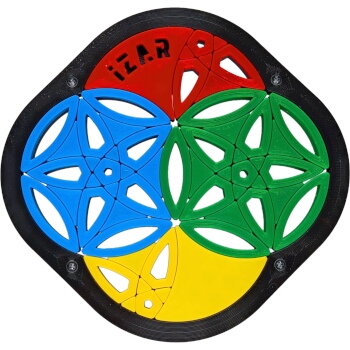|
Four intersecting circles in a jumbling puzzle. Two turns in five steps. Two in irrational angles.
Epsilon Boötis (ε Boötis, abbreviated Epsilon Boo, ε Boo), officially named Izar (/ˈaɪzɑːr/ EYE-zar), is a binary star in the northern constellation of Boötes. The star system can be viewed with the unaided eye at night, but resolving the pair with a small telescope is challenging; an aperture of 76 mm (3.0 in) or greater is required. It bore the traditional names Izar, Mirak and Mizar. Izar, Mirak and Mizar are from the Arabic: إزار ʾizār ('veil') and المراق al-maraqq' ('the loins') Epsilon Boötis consists of a pair of stars with an angular separation of 2.852 ± 0.014 arcseconds. The brighter component (A) has an apparent visual magnitude of 2.37, making it readily visible to the naked eye at night. The fainter component (B) is at magnitude 5.12, which by itself would also be visible to the naked eye. Parallax measurements from the Hipparcos astrometry satellite put the system at a distance of about 203 light-years (62 parsecs) from the Earth. This means the pair has a projected separation of 185 Astronomical Units, and they orbit each other with a period of at least 1,000 years. The brighter member has a stellar classification of K0 II-III, which means it is a fairly late-stage star well into its stellar evolution, having already exhausted its supply of hydrogen fuel at the core. With more than four times the mass of the Sun, it has expanded to about 33 times the Sun's radius and is emitting 501 times the luminosity of the Sun.[6] This energy is being radiated from its outer envelope at an effective temperature of 4,550 K, giving it the orange hue of a K-type star. The companion star has a classification of A2 V, so it is a main sequence star that is generating energy through the thermonuclear fusion of hydrogen at its core. This star is rotating rapidly, with a projected rotational velocity of 123 km/s. It has a surface temperature of about 9,000 K and a radius nearly three times the Sun, leading to a bolometric luminosity 45 times that of the Sun. By the time the smaller main sequence star reaches the current point of the primary in its evolution, the larger star will have lost much of its mass in a planetary nebula and will have evolved into a white dwarf. The pair will have essentially changed roles: the brighter star becoming the dim dwarf, while the lesser companion will shine as a giant star. Size: 145 x 145 mm Contributors
No one has contributed to this page yet! Collections This puzzle can be found in collections of these members: lianium: Lianium's collection Found a mistake or something missing? Edit it yourself or contact the moderator. |
|





